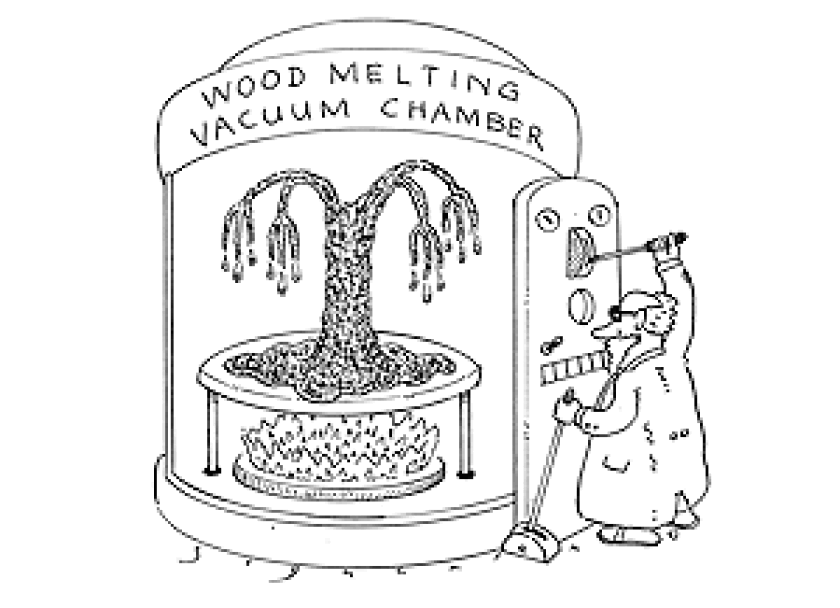Dear Cecil: I thought I was smart and all until my son asked me, “Why doesn’t wood melt?” Murli
Cecil replies:
The simple answer is that wood doesn’t melt because it burns first. If that seems a little like giving your son the brush-off, we can go into some more detail.
Typically substances go through two phase transitions as they’re heated up: solids melt into liquids, liquids boil into gases. There are plenty of exceptions to this basic pattern, though, and in some cases a chemical reaction transpires before the phase transition can take place. Here the reaction we’re talking about is combustion: anything with a combustion temperature lower than its melting temperature will burst into flames before it starts getting gooey.
So say you’re heating up a hunk of wood. Up through 500 degrees Fahrenheit or so, mostly what you’re doing is driving off moisture. As the temperature increases, though, the wood starts to break down chemically, liberating the lighter organic compounds (methane, methanol, etc) into the surrounding air in a process called devolatilization.
Somewhere north of 1,000 degrees these compounds will start to burn, and the resulting heat will ignite the final, least volatile portion of the wood: the stuff, largely carbon, that combustion pros refer to as char. After the char burns, what’s left is the ash, which consists of wood’s inorganic components — most often calcium, potassium, and magnesium compounds. And these minerals will in fact melt, usually at between 1,900 and 2,200 degrees. My assistant Una reports seeing huge wood-fired industrial furnaces where the molten ash runs down the walls like honey.
OK, someone pipes up from the back, but what if you heated the wood in a vacuum, so it couldn’t burn? Sigh. Well, the water and volatile matter would evaporate off in the early going, leaving behind the char. The inorganic stuff would then melt as described above, and finally, if you cranked the temperature way up to 6,400 degrees or so, the carbon itself would liquefy — which I guess is as close to melting wood as you’re going to get.
Dear Cecil:
Long ago you determined that it still cost less than a penny to mint a penny. It’s a far different world today, and I find it hard to believe that the cost of minting a penny is less than the face value.
— Westerr
Cecil replies:
No flies on you, Westerr. It’s true that as of 1998, when last we discussed this topic , minting pennies wasn’t a losing proposition. Each one then cost about four-fifths of a cent to manufacture, giving them a low but still positive profit margin — or seigniorage, as it’s known in the currency biz — of 20 percent. But that was then. Stamping out a one-cent piece now costs about 1.25 cents. Given pennies’ vestigial role in the economy, the government’s insistence on minting them has gone from pointless atavism to expensive hobby.
What happened? Well, copper’s gotten a lot pricier in the intervening decade — 75 cents a pound on the London Exchange in ’98, $3.84 as of deadline — but a penny is only 2.5 percent copper. The rest is zinc, and thanks to greatly increased demand from China, that’s been in short supply for a while now, sending the price up from 47 cents a pound to as much as $1.50. Zinc production is catching up, creating some relief, but it’s doubtful that making a zinc-copper penny will ever cost less than a penny again.
And the penny’s not even the big problem. The reigning negative-seigniorage champ is the humble nickel, which now has an extravagant price tag of about 7.7 cents. Nickels are 25 percent nickel and 75 percent copper, so here we’re dealing with the big price hike for copper plus a similar one for nickel: $2.10 a pound ten years back, $11.92 now. As demand for nickel has gone way up (China again being a major consumer), America has stopped supplying it: we had no nickel mines in operation last year, and we sold off the last of our strategic reserves in 1999. (According to the U.S. Geological Survey, the Energy Department’s got maybe 14,000 tons of nickel lying around that’s been “contaminated by low-level radioactivity,” but that’s little help. Who’s going to take a radioactive nickel?)
Concerned about coins disappearing from circulation, the mint introduced a regulation last year levying a $10,000 fine against anyone who melts down pennies or nickels for the metal. Great, but they’ll have to catch a lot of melters to put a dent in the many millions we’re losing annually by making the coins at all. Amid general resignation that neither the penny nor the nickel is going away anytime soon, the House just passed a bill requiring that henceforth both be made from less-expensive steel. The Treasury Department opposes it, but something’s gotta give. A country that’s $9.4 trillion in the hole could clearly stand to quit throwing so much good money after bad.
Cecil Adams
Send questions to Cecil via cecil@straightdope.com.
